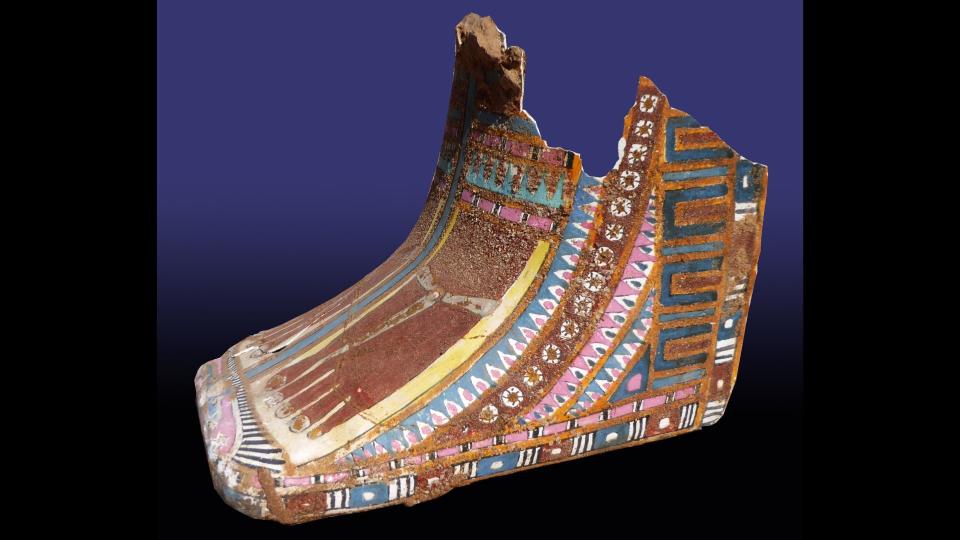Archaeologists have unearthed more than 30 ancient Egyptian tombs that cover an entire hill in Aswan, an ancient city on the Nile. The burials date to the Greco-Roman period and reveal clues about those who once lived in this vibrant trading port.
The finds include the mummies of what are likely families buried together; coffins; cartonnage, or a paper-mache material created from recycled papyri or fabric; amphorae, or clay vessels, decorated with vine-leaf designs; and artifacts such as offering tables.
“It was a rich place, an important place,” said Patrizia Piacentini, an Egyptologist and archaeologist at the University of Milan who leads a joint Egyptian-Italian mission at the site. “All the people who intended to make trade between Northern Africa and subtropical Africa, this was the place [for them] and it was a place for all the history of ancient Egypt,” she said.
Archaeologists learned about the burial site in 2015, following a slew of illegal excavations. The government asked local archaeologists to survey the area, and soon thereafter excavators discovered tombs dating to the late Greek and Roman periods (roughly 332 B.C. to A.D. 395).
The former Egyptian minister of antiquities, Khaled el-Enany, then reached out to Piacentini, who began surveying the site with a large team of Egyptian and Italian archaeologists in 2019. The researchers found terraces of ancient tombs stratified into multiple levels on the hill near the modern Mausoleum of Aga Khan III.
Related: See gorgeous ancient Egyptian ‘mummy portraits’ from nearly 2 millennia ago
During the excavation, the archaeologists found ancient oil lamps that were possibly left behind by mourners.









“We can imagine how spectacular it was when, for example, during the [mourners’] feast, all these tombs were illuminated,” Piacentini told Live Science. “I think that was something absolutely spectacular.” These tomb structures were built into the rock at a vertical height of at least 10 levels and were unlike any other tombs found in Egypt from the period, which were usually about two to three levels high, she said.
The tombs were used for around 900 years between the sixth century B.C. and the second or third century A.D., Piacentini said. This period covers a wide spread of history, including Persian rule (525 to 404 B.C.), the Greek Ptolemaic dynasty ushered in by Alexander the Great‘s general Ptolemy I Soter, and finally Roman rule, when Egypt became a province in the empire. The elites of the day occupied the tombs at the top of the hill, followed by the middle-class people in the lower strata, Piacentini said.


Analyses revealed that 30% to 40% of the mummies in the newly discovered tombs belong to children as young as 2 years old and newborns, according to a translated statement from the Egyptian Ministry of Tourism and Antiquities.
“We found many families, in fact, mother, father, and children,” Piacentini said. “Probably there was some infection that killed the family or one died after another.”
The team also found two mummies that they initially thought belonged to a mother and son, but careful analyses later revealed that the duo were brothers buried together with their parents.


RELATED STORIES
—Why are so many ancient Egyptians buried at the Saqqara necropolis?
—Ancient Egyptians tried to treat cancer 4,000 years ago, cut-marked skull indicates
—4,300-year-old Egyptian tomb with stunning wall paintings was burial place of priestess and royal official
To find out more about how the individuals died, the team partnered with doctors at the University Hospital in Aswan to perform analyses such as X-rays, CT (computed tomography) scans and DNA analysis, which showed that anemia and infectious diseases were the most common causes of death at the time, even in the most affluent individuals, Piacentini said.
By looking at the mummies’ backbones, the doctors confirmed that some had tuberculosis, which may have wiped out an entire family. The team is conducting biological analyses to understand more about the diseases that infected people at the time.
The discovery has been “exceptional” and “very promising with many, many new aspects we are trying to understand.” Piacentini said.


The team hopes to continue its mission to uncover the history of the diverse populations that occupied the city. They have now mapped out at least 300 tombs in the necropolis area covering about 215,000 square feet (20,000 square meters) and “there may be much more than that,” Piacentini said.
Source Agencies


